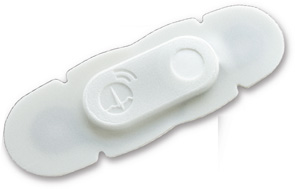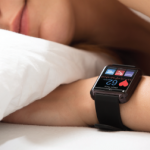
Eric Selvik looks down at his hand and sees his heart. Not literally—but he does see a visual representation of the electrical activity of his heart.
Selvik, vice president of strategic marketing for Vital Connect, a company that develops wearable medical technology, has a HealthPatch MD stuck to his chest. The patch is a device similar to a large Band-Aid, with an ECG lead, a battery and a module that communicates with a smartphone or other Web-enabled device by way of Wifi or a mobile network. It’s geared toward patients with known heart conditions.
Selvik’s phone shows a regular, healthy pattern on his ECG reading, thankfully. He doesn’t have a medical condition requiring heart monitoring, but keeps it on for the sake of his job.
Plus, he says, it’s “just kinda cool.”
Usage Expanding
Wearable cardiac monitoring devices, such as HealthPatch, could become more widely considered in the care of patients with rheumatologic conditions. People with rheumatoid arthritis are at a heightened risk of having a heart attack and heart failure.
HealthPatch MD and BodyGuardian—another FDA-approved cardiac sensor worn as a patch that sticks to the skin—are part of the growing wearable-technology healthcare sector. One research group, Zurich-based Soreon Research, estimates that the $2 billion wearable-medical-device market will explode to a $41 billion industry by 2020.
“Heavy regulation of the healthcare industry and the inherent conservatism of many healthcare professionals will somewhat hinder the adoption of these new technologies,” Soreon researchers wrote in a report last year. “The penetration of smart wearable healthcare technology will take years, even decades in some cases. However, the ubiquity of mobile devices and networks—even in the remotest areas of the world—and consumers’ growing savviness about mobile technology are pushing the adoption of these technological innovations.”
How It Works
HealthPatch MD, developed by Vital Connect, won FDA approval last year for accurately measuring cardiac indicators, such as ECG, heart rate and heart rate variability, as well as clinical-grade respiratory rate measurement, skin temperature, step count, body posture and fall detection.
The device is being used in clinical studies, and more regular clinical use is expected later this year through partnerships, such as its agreement with LifeWatch, a company that offers remote patient monitoring services to doctors. Although HealthPatch MD has received FDA clearance for the monitoring of vital signs, LifeWatch is now pursuing approval for using those metrics to actually make diagnoses.
The company has already partnered with Medidata for use in clinical trials.
The module part of HealthPatch MD is reusable, but the patch that sticks to the skin contains the battery, which lasts just two or three days, depending on whether data are constantly being streamed to a mobile device. So the patch needs to be changed regularly.
That involves sliding the reusable module—a thin, wafer-like object similar to the SD card of a digital camera—out of the center of the patch and then removing the backing, exposing the adhesive, and reattaching the HealthPatch to the skin.
The ubiquity of mobile devices & networks, … & consumers’ growing savviness about mobile technology are pushing the adoption of these technological innovations.
“It’s a fairly simple process,” Selvik says.
The device is okay for use in the shower, but there are different grades of adhesive geared toward different levels of activity and different levels of perspiration. The device comes with “gentle,” “active” and “high performance” adhesive options. The advantage of the gentle is that the patch can be taken on and off more freely; once one of the stronger adhesives is used, it can typically not be reattached, and another patch would be needed, Selvik says.
He acknowledges that the need to change the patch with the battery so frequently makes the device less desirable for use as a general wellness tool. But that is not the target user, he says.
Designed for Medical-Grade Data
“This device makes sense for people on the extremes of health,” he says. “Either you’re sick and you have a known issue, or you’re a super athlete and you want medical-grade information about what you’re doing.
“This device is a medical device, and we are focused squarely on medical applications vs. the wellness and the fitness [users].”
Selvik says the device could also have an impact in the inpatient setting, where patients could be monitored much more closely than they are now—only when a nurse does rounds.
“That happens maybe once or twice a shift,” he says. “The thing is, people can decline very, very rapidly, and you’d really like to know within minutes if you’re seeing a significant change in someone’s vital signs rather than hours. And that will save lives.”
Study Needed
Enthusiasm was limited for at least two rheumatologists who have studied the links between rheumatologic diseases and cardiovascular events.
“This is similar to another device on the market called BodyGuardian,” says Eric Matteson, MD, chair of rheumatology at Mayo Clinic. “Neither of these has been demonstrated to be of value as a home health accessory. I think at the moment we cannot say that it would have value at this time in the context of preventative cardiology. I would not recommend it until it is better studied in the context of preventive cardiology.”
Jane Salmon, MD, Collette Kean Research Chair at the Hospital for Special Surgery in New York, also says its value might be limited.
“Patients with RA and SLE are at increased risk for heart attacks, compared to controls matched for conventional cardiovascular risk factors, but their risk is still not very high, particularly when they are young,” she says. “For example, myocardial infarctions are very uncommon in young women. In SLE, they may be 10 to 50 times more frequent, but that is still quite rare.
“I do not feel that monitoring would be useful in most rheumatology patients without histories of cardiac events,” she adds. “It could make patients anxious, and the frequency of events is probably too low to make this worthwhile. In a patient considered sufficiently high risk to require this device, a cardiologist would be better suited to monitor output of the device.”
Thomas R. Collins is a freelance medical writer based in Florida.

